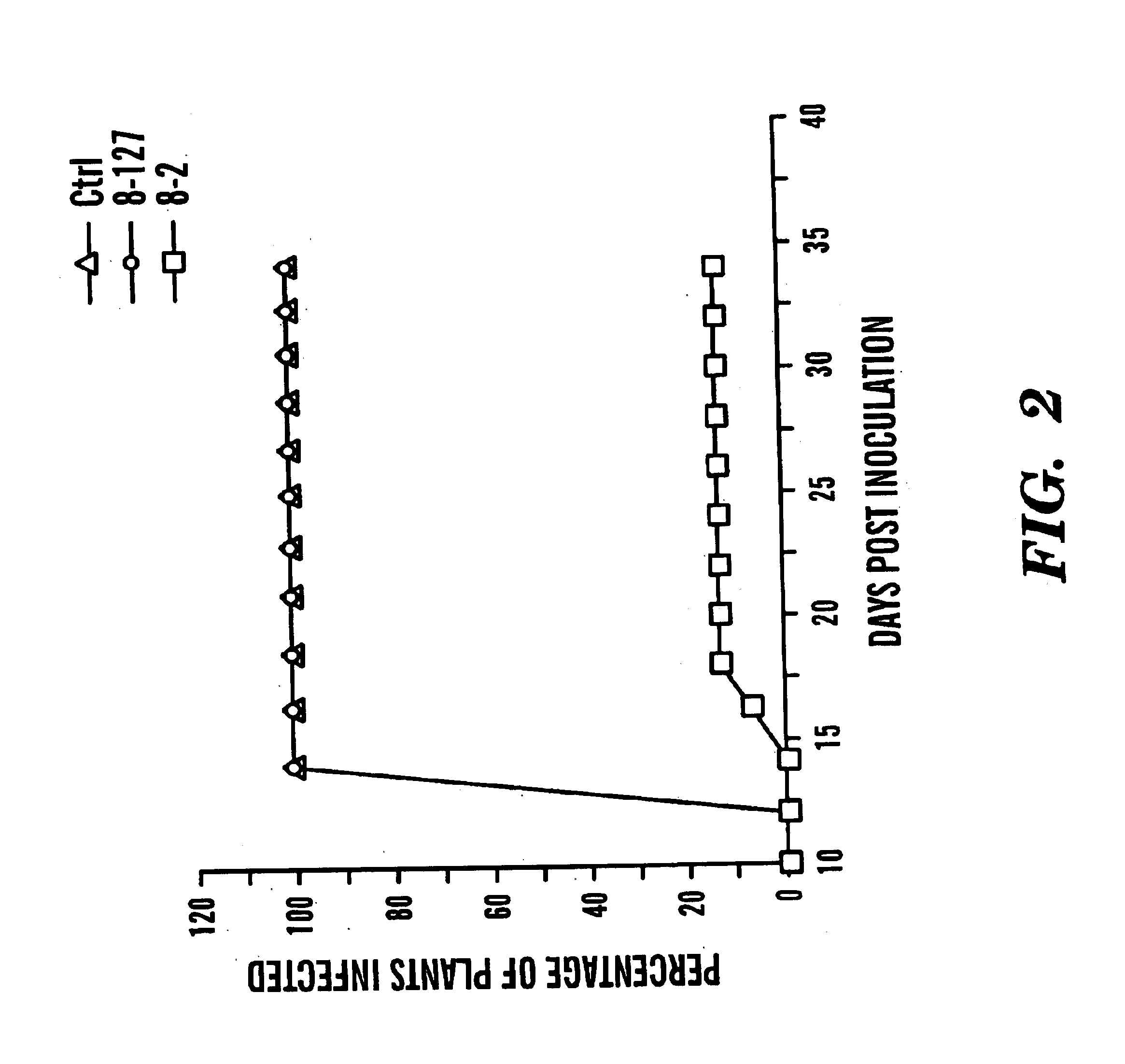DNA constructs and methods to impart resistance to at least one virus on plants
- Summary
- Abstract
- Description
- Claims
- Application Information
AI Technical Summary
Benefits of technology
Problems solved by technology
Method used
Image
Examples
example 1
Cloning and Transformation
[0065]The N gene (Pang, S.-Z., et al., “Resistance to Heterologous Isolates of Tomato Spotted Wilt Virus in Transgenic Plants Expressing its Nucleocapsid Protein Gene,”Phytopathology, 82: 1223-29 (1992), which is hereby incorporated by reference) of the lettuce isolate of tomato spotted wilt virus (TSWV-BL) was used as the template for construction of the N gene fragments of various lengths using the primers listed in Table 1.
[0066]
TABLE 1Primers used in cloningNamePositions1SequenceFor the N gene fragments91-842776-27445′-AGCTAATCTAGAACCATGGATGACT(SEQ. ID. NO. 1)93-892669-26505′-TACAGTTCTAGAACCATGGTCTGGA(SEQ. ID. NO. 2)93-852576-25565′-TACAGTTCTAGAACCATGGTAAAGC(SEQ. ID. NO. 3)92-552373-23545′-AGATTCTCTAGACCATGGTGACTTGATGAGCAAAGTCTGTGAGGCTTGC(SEQ. ID. NO. 4)93-912266-22485′-TACAGTTCTAGAACCATGGAAAATA(SEQ. ID. NO. 5)93-872153-21335′-TACAGTTCTAGAACCATGGTAGAAG(SEQ. ID. NO. 6)90-471918-19375′-AGCATTGGATCCATGGTTAACACAC(SEQ. ID. NO. 7)93-862158-21775′-TCTTGAGGATCC...
example 2
ELISA, Northern Blot Analyses of Transgenic Plants
[0070]Double antibody sandwich enzyme-linked immunosorbent assay (“DAS-ELISA”) was used to detect the nptII enzyme in transgenic plants using an nptII ELISA kit (5 Prime to 3 Prime, Inc). Northern blot was performed as described previously (Pang, S. Z., et al., “Different Mechanisms Protect Transgenic Tobacco Against Tomato Spotted Wilt and Impatiens Necrotic Spot Tospoviruses,”Bio / Technology, 11: 819-24 (1993), which is hereby incorporated by reference).
example 3
Inoculation of Transgenic Plants
[0071]Inoculations were done as described previously (Pang, S.-Z., et al., “Resistance to Heterologous Isolates of Tomato Spotted Wilt Virus in Transgenic Plants Expressing its Nucleocapsid Protein Gene,”Phytopathology, 82: 1223-29 (1992), which is hereby incorporated by reference). Systemic symptoms were recorded every other day for at least two months.
PUM
| Property | Measurement | Unit |
|---|---|---|
| Electric potential / voltage | aaaaa | aaaaa |
| Electric potential / voltage | aaaaa | aaaaa |
| Electric potential / voltage | aaaaa | aaaaa |
Abstract
Description
Claims
Application Information
 Login to View More
Login to View More - R&D
- Intellectual Property
- Life Sciences
- Materials
- Tech Scout
- Unparalleled Data Quality
- Higher Quality Content
- 60% Fewer Hallucinations
Browse by: Latest US Patents, China's latest patents, Technical Efficacy Thesaurus, Application Domain, Technology Topic, Popular Technical Reports.
© 2025 PatSnap. All rights reserved.Legal|Privacy policy|Modern Slavery Act Transparency Statement|Sitemap|About US| Contact US: help@patsnap.com



